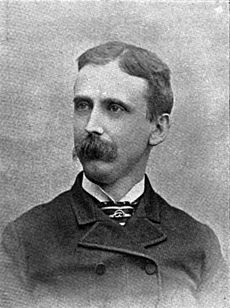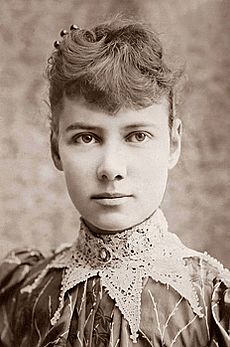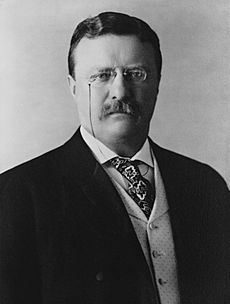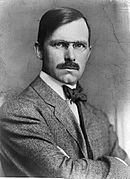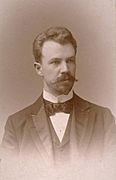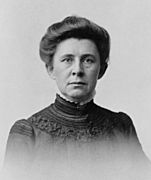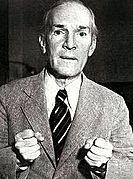Muckraker facts for kids
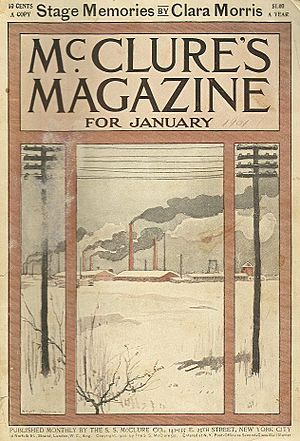
The muckrakers were brave journalists, writers, and photographers in the Progressive Era (from the 1890s to the 1920s) in the United States. They worked to show the public unfairness and bad actions happening in big companies and government. They often did this through exciting articles in magazines and newspapers. Today, the term "muckraker" sometimes refers to investigative journalists who dig deep to find important facts.
Muckrakers played a very important role during the Progressive Era. Magazines like McClure's helped to expose huge companies that had too much power. They also showed how political groups sometimes cheated the system. These journalists wanted to make people aware of problems like poverty in cities, dangerous work conditions, and child labor. Most muckrakers wrote true stories, but some fictional books, like those by Upton Sinclair, also had a big impact.
The word "muckraker" comes from a character in John Bunyan's old book, The Pilgrim's Progress. This character, "the Man with the Muck-rake," only looked down at dirt and ignored good things. President Theodore Roosevelt made the term popular in a 1906 speech. He said that muckrakers were often very important for society, but they needed to know when to stop.
Contents
How Muckraking Journalism Started
Journalism that would later be called "muckraking" began around 1900. Before this, there were already some reform writings. By the early 1900s, magazines like Collier's Weekly, Munsey's Magazine, and McClure's Magazine were very popular. Many middle-class families read them.
The January 1903 issue of McClure's is often seen as the official start of muckraking journalism. In that one issue, Ida M. Tarbell wrote about the Standard Oil Company. Lincoln Steffens wrote about corruption in cities, and Ray Stannard Baker wrote about coal mine workers. These were all very famous works. An earlier article by Lincoln Steffens in McClure's in October 1902, called "Tweed Days in St. Louis," is considered the very first muckraking article.
Changes in News Reporting Before 1903
Muckrakers became famous for their deep investigative journalism. This style of reporting grew out of earlier types of journalism. In the 1800s, newspapers were often run by strong leaders who shared their own opinions. Later, "yellow journalism" became popular, which focused on exciting stories and sensationalism to sell more papers.
One big scandal after the Civil War was about William M. Tweed in 1871. Newspapers uncovered his corruption and bribery in New York. Lincoln Steffens' first muckraking article, "Tweed Days in St. Louis," showed how political corruption, called graft, was deeply rooted in that city.
Some muckrakers, like Steffens, had worked for newspapers that focused on reform. Others, like Charles Edward Russell, had worked for "yellow journals" before moving to magazines around 1900. Publishers of yellow journals, such as Joseph Pulitzer and William Randolph Hearst, mainly wanted to sell more papers. They used scandal, crime, and exciting stories to do this. If they exposed a social problem along the way, that was a bonus, but it wasn't their main goal. Muckrakers, however, truly aimed to fix social wrongs.
Journalists before the muckrakers also gained fame for their investigations. Julius Chambers of the New York Tribune is sometimes called an early muckraker. In 1872, he pretended to be mentally ill to get himself admitted to Bloomingdale Asylum. He wanted to find out about alleged abuse of patients. His articles in the Tribune led to changes at the asylum and new laws about mental health care.
Nellie Bly, another journalist, also used undercover methods. In 1887, she wrote Ten Days in a Mad-House after pretending to be a patient at Bellevue Mental Hospital. Her articles showed how patients were treated badly. Nellie Bly later wrote about corrupt politicians and unfair working conditions.
Other Important Works Before Muckrakers
Several other writers exposed problems before the main muckraking era:
- Helen Hunt Jackson (1831–1885) wrote A Century of Dishonor about how the U.S. government treated Native Americans.
- Henry Demarest Lloyd (1847–1903) wrote Wealth Against Commonwealth, showing corruption in the Standard Oil Company.
- Ida B. Wells (1862–1931) wrote articles about Jim Crow laws and co-owned a newspaper called The Free Speech.
- Jacob Riis (1849–1914) wrote How the Other Half Lives, using flash photography to show the terrible conditions in city slums. His work helped bring about changes to housing.
Muckrakers appeared when journalism was changing. Some newspapers, like The New York Times, started to focus on objective reporting, meaning they reported facts without sensationalism. Muckraking publishers like S. S. McClure also wanted factual reporting, but they also wanted stories to be exciting and interesting to a large audience. Unlike objective reporters, muckrakers saw themselves as reformers. They were actively involved in the Progressive movement. They used investigative stories and exciting details, like yellow journalism, but their main goal was to change society for the better. Their work reached many people, and magazine sales grew because of public interest.
Popular Muckraking Magazines
Magazines were the main way muckraking journalism reached people. Samuel S. McClure and John Sanborn Phillips started McClure's Magazine in 1893. McClure made magazines more affordable by cutting the price to 15 cents. This attracted more readers and advertisers. Other magazines like Munsey's and Cosmopolitan followed his lead.
McClure hired talented writers, including the then-unknown Ida M. Tarbell and experienced journalist Lincoln Steffens. Many famous muckrakers wrote for McClure's, such as Ray Stannard Baker, Burton J. Hendrick, and George Kennan (explorer). Their names often appeared on the magazine covers.
Other important magazines that featured muckraking journalism included:
- American Magazine (with Lincoln Steffens)
- Collier's Weekly (with Samuel Hopkins Adams and Upton Sinclair)
- Cosmopolitan (with Jack London and Charles Edward Russell)
- Everybody's Magazine (with William Hard and Upton Sinclair)
- Hampton's (with Rheta Childe Dorr and Charles Edward Russell)
Where the Term "Muckraker" Came From
After President Theodore Roosevelt became president in 1901, he worked closely with the press. He even made his press secretary a cabinet member and started holding press conferences. However, the new muckraking journalists, like Lincoln Steffens, were harder for Roosevelt to control. He gave Steffens access to the White House to try and guide his stories.
Roosevelt used the press to get support for his "Square Deal" policies. But when journalists started focusing on negative topics, he complained about them "wallowing in the mud." In a speech on April 14, 1906, he talked about a character from John Bunyan's 1678 book, The Pilgrim's Progress:
...you may recall the description of the Man with the Muck-rake, the man who could look no way but downward with the muck-rake in his hands; who was offered a celestial crown for his muck-rake, but who would neither look up nor regard the crown he was offered, but continued to rake to himself the filth of the floor.
Roosevelt warned about always focusing on the bad things, but he also said that investigative reporting was good for society:
There are, in the body politic, economic and social, many and grave evils, and there is urgent necessity for the sternest war upon them. There should be relentless exposure of and attack upon every evil man whether politician or business man, every evil practice, whether in politics, in business, or in social life. I hail as a benefactor every writer or speaker, every man who, on the platform, or in book, magazine, or newspaper, with merciless severity makes such attack, provided always that he in his turn remembers that the attack is of use only if it is absolutely truthful.
Most of these journalists did not like being called "muckrakers." They felt that Roosevelt had betrayed them, especially after they had helped him get elected. Muckraker David Graham Phillips believed that this label made it easier to group and attack the journalists, which eventually helped end the movement.
However, the term "muckraker" eventually came to mean investigative journalists who reported on and exposed problems like corruption, fraud, waste, and unfair business practices. Muckrakers often investigate both businesses and the government.
Important Muckraking Works of the Early 1900s
- Early writers of the muckraking tradition
-
Mark Sullivan with his secretary, Mabel Shea
Here are some of the most important works by muckrakers:
- Ray Stannard Baker wrote "The Right to Work" in McClure's Magazine in 1903. It was about the dangerous conditions in coal mines and the struggles of workers during a strike. He showed the risks faced by both striking and non-striking workers.
- Lincoln Steffens published "Tweed Days in St. Louis" in McClure's Magazine in October 1902. This article exposed corrupt leaders in St. Louis. Its fame helped a lawyer named Joseph Folk investigate the city's corrupt political system.
- Ida Tarbell published The History of The Standard Oil Company in 1902 and 1908. She showed how John D. Rockefeller's Standard Oil Company used unfair and harsh business methods to create a monopoly. Her book made the public very angry. This anger helped lead to the breakup of Standard Oil under the Sherman Anti Trust Act.
- Upton Sinclair published The Jungle in 1906. This book revealed the terrible conditions in the meat packing industry in the United States. It played a big part in creating the Pure Food and Drug Act and the Meat Inspection Act. Sinclair wrote the book to show the unsafe working conditions, not primarily food safety. He considered himself a muckraker.
- "The Treason of the Senate" by David Graham Phillips appeared in Cosmopolitan magazine in 1906. It described corruption in the U.S. Senate. This work was key to creating the Seventeenth Amendment. This amendment allowed people to directly elect their senators, rather than state legislatures choosing them.
- The Great American Fraud (1905) by Samuel Hopkins Adams exposed false claims about patent medicines. These medicines often made big promises but had little effect. Adams showed how companies sold these ineffective products at very high prices. His work, along with Upton Sinclair's, helped lead to the Pure Food and Drug Act.
Many other muckrakers brought various issues to light during the Progressive Era. They focused on topics like monopolies, meat processing, child labor, and unfair working conditions. In many cases, what these journalists revealed led to public anger, government investigations, and new laws. These laws addressed problems like pollution, food safety, unfair labor, and fraud. The work of muckrakers, both then and now, helps improve laws and society.
List of Muckrakers and Their Contributions
- Samuel Hopkins Adams (1871–1958) – The Great American Fraud (1905), exposed false claims about patent medicines.
- Ray Stannard Baker (1870–1946) – Wrote for McClure's and The American Magazine.
- Louis D. Brandeis (1856–1941) – Wrote Other People's Money And How the Bankers Use It (1914) about big banks and businesses.
- Edwin Markham (1852–1940) – Published Children in Bondage (1914), exposing child labor.
- Gustavus Myers (1872–1942) – Documented corruption in his book "The History of Tammany Hall" (1901) and "History of the Great American Fortunes" (1909–10).
- Frank Norris (1870–1902) – Wrote The Octopus, about railroad power.
- Jacob Riis (1849–1914) – How the Other Half Lives, showed the terrible conditions in city slums.
- Charles Edward Russell (1860–1941) – Investigated the Beef Trust and prison conditions in Georgia.
- Upton Sinclair (1878–1968) – The Jungle (1906), exposed the US meat-packing industry.
- John Spargo (1876–1966) – The Bitter Cry of Children (1906), about child labor.
- Lincoln Steffens (1866–1936) – The Shame of the Cities (1904), uncovered corruption in major cities.
- Ida M. Tarbell (1857–1944) – Wrote the famous exposé, The History of the Standard Oil Company.
- John Kenneth Turner (1879–1948) – Author of Barbarous Mexico (1910), about unfair labor in Mexico.
- Ida B. Wells (1862–1931) – The Free Speech (1892), criticized flaws in the justice system that allowed lynching.
Why Muckraking Declined
The influence of muckrakers started to lessen during the presidency of William Howard Taft. Big companies and political leaders also became better at stopping these journalists. Sometimes, advertisers would stop supporting magazines, forcing some to close down.
However, the muckrakers had already made a huge difference. Their exposés led to many reforms in cities, businesses, and politics. Monopolies like Standard Oil were broken up, and corrupt political groups lost power. As many of the problems they exposed were fixed, the need for that specific type of muckraking journalism decreased.
The Lasting Impact of Muckrakers
The journalism of the muckrakers led to new laws and legal actions that had a lasting impact. For example, it helped end Standard Oil's control over the oil industry. It also led to the creation of the Pure Food and Drug Act of 1906 and the first child labor laws in the United States around 1916. Their reports showed bribery and corruption in local and state governments, and even in Congress. This led to important reforms and changes in election results.
Their work had a deep effect on the country. It's not a coincidence that the time of the muckrakers was also a time of great change and energy in America. People were upset by the corruption and wrongs of the time, and the muckrakers helped inform and motivate them. This led to a big wave of progress and reforms, including many new laws passed during Woodrow Wilson's presidency from 1913 to 1917. The muckrakers truly paved the way for these changes.
Other changes that came from muckraker articles included a reorganization of the U.S. Navy. Muckraking investigations also helped change how senators were elected through the Seventeenth Amendment. They also led to government agencies taking on roles to watch over and protect the public.
Muckraking Today
Today, the term "investigative journalism" is often used as a synonym for muckraking. Many journalism textbooks say that the high standards of muckraking have become a key part of modern investigative journalism. The successes of the early muckrakers continue to inspire journalists.
Muckraking has become a very important part of American journalism history. For example, Bob Woodward and Carl Bernstein exposed the actions of the Nixon Administration in the Watergate scandal. This eventually led to Nixon's resignation. More recently, Edward Snowden revealed government spying activities, which showed the public how much their privacy was being affected.
See also
 In Spanish: Muckraker para niños
In Spanish: Muckraker para niños


